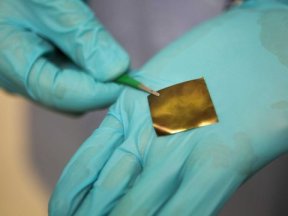 Flexible electronics are the gateway to a new generation of phones, brain implants, artificial limbs, solar cells, and limitless other devices that benefit from the ability to bend, fold, and rollup.
Flexible electronics are the gateway to a new generation of phones, brain implants, artificial limbs, solar cells, and limitless other devices that benefit from the ability to bend, fold, and rollup.
The problem is figuring out how to make them.
Stretchability and conductivity are difficult properties to combine. Materials that are good conductors do not stretch well and materials that do stretch well are not good conductors.
This happens because the stretching of solid material lengthens chemical bonds, changing the distance between atoms, and in turn, decreasing conductivity. Alternatively, the crystalline structures of metals, which makes them good conductors of heat and electricity, are hard to mold since their internal bonds are not very forgiving.
“This is the story throughout the entire family of stretchable conductors,” said study researcher Nicholas Kotov, a professor of engineering at the University![]() of Michigan, who may have developed the best stretchy conductor yet.
of Michigan, who may have developed the best stretchy conductor yet.
The new material is made from gold nanoparticles that are embedded in a flexible synthetic material called polyurethane. The bendy film, described in a paper published in Nature on Wednesday, July 17, can conduct electricity even when stretched to more than twice its original length.
Scientists used electron microscope images to see what happened when the material was stretched. It turns out that the gold nanoparticles aligned into chains when pulled — instead of becoming disorganized — creating a good conducting pathway. Importantly, the nanoparticles rearranged themselves when the strain was released, meaning the process is reversible.

The gold nanoparticles are produced in the lab, represented by this deep purple substance.
The secret lies in the gold nanoparticles, which were made in the lab so that they they would have a very thin shells on their surface. The thin shells are much better than thicker traditional shells.
“This is important because the shell stabilizes the particles and typically prevents the transfer of electrons from one nanoparticle to the other,” Kotov told Business Insider.
Without a thick shell, the electrons can hop from one nanoparticle to another more easily and are able to conduct electricity very well.
The practical applications of elastic metal are far-reaching, but Kotov is particularly interested in how his material can be used to improve medical devices.
There are a number of implantable devices for the brain, heart, and muscles. The problem with these rigid electrodes is that the human tissue easily recognizes them as foreign materials and generates scar tissue as a response, explains Kotov. The scar tissue reduces the performance of implantable devices. A pliable material that is more akin to our soft tissue is key to longer-term implants.
The search for a material that has the unusual combination of stretchability and electrical conductivity is ongoing, but this is a critical step forward.
You must be logged in to post a comment.